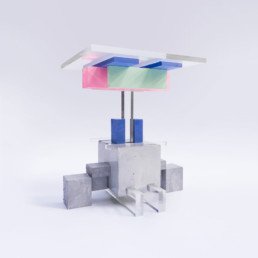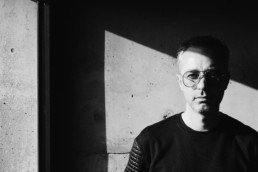Iassen MarkovTechnobeton VII, 2016NT (Night Table)Edition of 25
Iassen MarkovTechnobeton VII, 2016NT (Night Table)Edition of 25
Born 1980 in Sofia, Bulgaria, lives and works in Stuttgart, Germany
Education
1999-2000
Studies in Ecology at the University of Sofia, Bulgaria
2000-2006
Studies in architecture at the University of Stuttgart, Germany
Academic positions
2015
Visiting assistant professor at Professorship Architectural and Cultural Theory at the TUM Department of Architecture, Technical University of Munich, Germany
2010
Visiting lecturer at the postgraduate spatial design program at Zurich University of the Arts (ZHdK), Switzerland
2008
Visiting guest critic at Department for Architectural Design and Innovation (ADIP) at TU Berlin, Germany
2007
Assistant professor at Institute for Basics of Modern Architecture and Planning (IGMA) at the University of Stuttgart, Germany
2006
Summer School Unit Master for Architectural Theory at Architectural Association School of Architecture (AA), London, UK
Fellowships
2007-2008
Fellowship for Architecture at Akademie Schloss Solitude, Stuttgart, Germany
Solo Exhibitions
2016
Curator´s Selection #5, Collect Good Stuff
2011
Houses for Friends and Enemies,Bulgarian Art Institute, Prague
2008
Ten years Game over, Dialekt Kunstverein Stuttgart, Stuttgart
Group Exhibitions
2016
Tschuschkopek, Sofia Museum for Contemporary Art, Underground Art Festival, Sofia
2015
Momentalism, Architecture Gallery, Munich
2014
apocalyptic black forest (as Divine Design with Julian Friedauer), New Old Black Forest Festival, Freiburg
2012
Digital Arts Festival, Sofia
Alphapretation Bulgaria, University Gallery Uppsala
Alphapretation Bulgaria, Wittgenstein Haus, Vienna
2008
Stay stay stay, Früheres Mineralbad Sofia, Sofia
2009
Markov Associati. Progetti Internazionali, Akademie Schloss Solitude, Stuttgart
Selected Performances
2016
Palermo Gallery, Stuttgart
Dresden Bar, Stuttgart
Sofia Museum for Contemporary Art, Sofia
Technobeton, b612 Keller, Stuttgart
2015
Architekturgalerie München, Munich
2014
Shanghai fashion week, Shanghai
MIPIM, Cannes
exporeal, Munich
New Old Black Forest Festival, Freiburg
2013
Dresden Bar, Stuttgart
exporeal, Munich
2012
Leipzig Kongresszentrum, Leipzig
Freischwimmer, Berlin
2011
Architektenkammer Zürich, Zurich
Watergate, Berlin
2010
Galeria Industrialna, Sofia
Bundesministerium für Verkehr und digitale Infrastruktur, Berlin
Architekturbiennale, Venice
Underground Art Festival, Sofia
Fetish + Consum, Akademie Schloss Solitude, Stuttgart
Selected Projects
2015
Styroporgalerie Weiße Wanne, Stuttgart
Wumkombinat (video)
Sanatornaja (video)
2014
X Bulgarian Rockets, Trud Gallery, Plovdiv
VOH backgrounds, VOH Magazine release night, Berlin
2013
micromegas, Stuttgart
2012
Transsib LP (as Divine Design with Julian Friedauer)
Lotto Interiors
2011
divine design release gifs
Postapocalyptic Calender (as Divine Design with Julian Friedauer), Ebene 0, Stuttgart
Planungskollektiv VII, Symposium socialistic architectural heritage, Leipzig
2010
Intergerman Autobahn Kalender, Sofia
Houses for friends and enemies, Galeria Industrialna, Sofia
Art Today Association, center for contemporary art, Plovdiv
Ruse, International Elias Canetti Community
Bulgarian Art Institute, Prague
Publications
2014
Italic Architecture, This must be the place Verlag, Stuttgart
2012
Lotto Interiors, Lotto International Publishers
2011
Postapocalyptic Calender (as Divine Design with Julian Friedauer), The Divine Design Press Ltd.
2010
Almannacco della Vera Architettura Seggretta, Assozziatti Verlag
Houses for Friends and Enemies, limited Edition, Iassen Markov, self published
2008
Faust und der Marquis, igmade edition
2006
5 Codes: Architecture, Paranoia and Risk in times of Terror, Birkhäuser Verlag
INTERVIEW
Iassen Markov about his project „Technobeton“
JG: When did you start the project „Technobeton“?
IM: It has been started in my mind a long time ago, maybe some thirty years (laughing)… I was recently not sure if I shall launch it, or not, until I jumped from a cliff during the Cagliari performing art festival last year. I think this was the beginning for Technobeton in the real world.
JG: The name „Technobeton“ reflects both the duality of the project and your interests. You studied architecture and are producing music. Can you tell us how the two parts come together and influence each other?
IM: I first noticed the connection between techno and beton when I was three or four years old. My grandfather ran a mill, where I used to play among flour fog and pounding bass vibrations of the huge round mill stones. It was a nice feeling of being lost in the right place. When he repaired the stones, he was hitting on them with a very sharp spark-throwing hammer, and the mineral sound echoed in the big building. These stones looked like giant records. Then I studied architecture, and started with producing, but it’s the second and not so important part of the story.
JG: What does the blurring of the boundaries between music, architecture and art mean to you?
IM: The first concept and visualization of the Technobeton VII furniture project was made in ableton composition view (laughing), which is a music program. I would also use these arrangements to explain the objects (or furniture pieces) during a lecture, because it’s very similar to a music piece: the colorful elements the objects are made of have a specific function, as different tracks have specific functions for the song (bass, claps, melody…) I could have made a chair by intending to make chair, but instead of this I prefer to make a music track and somehow persuade myself and everybody else, that this music track is a chair. I doubt, that the best chairs or other pieces of furniture have been made by intending to make exactly this specific chair, or to make exactly this specific piece of furniture. I prefer to blur the frame and like to don’t know what will be the end product, straightforwardness, without being motion blurred bores me.
JG: Let’s talk about the edition „Technobeton VII“ for Collect Good Stuff. What was the idea behind this furniture edition which can serve on the one hand as a functional piece of furniture on the other hand works as an autonomous art work?
IM: Technobeton VII is like an old man who refused to move in his whole life, but now in the end of his life he gets the chance to learn light athletics. He has seven tries, and starts low, but it’s getting better with the time. The energy, which he’s been saving his whole life now comes out in heavy expressive explosion of uncanny moves. If you look at the movie, the objects appear suddenly from the light horizon, without development, or preparation. In fact they have been made in the manner of a very urgent furniture project, with no pre-knowledge about furniture and with no calculation about effort. They are suddenly there and are too fast gone for annoying functional qualities and regulations which want to stick on them and plague them. So this furniture is about the fusion of too much mass and too much speed =>technobeton, which might be the formula for escaping the ballast of functional life.
JG: Apart from techno music which designers, architects or artists affect you the most regarding the furniture objects of the edition?
IM: Bulgarian trash design, Memphis Design, abandoned construction places, Claude Parrent, Metallica, very early DOS games, quadratic car design, Henry Matisse, Kazimir Malevich, the colors of BASF Styrodur and Derivat products.
JG: Let’s focus on the film „Technobeton C“ which is a considerable part of the online exhibition. What role does it play for the edition?
IM: Ah ok unintentionally answered already this question to a certain extent. The film doesn’t show really the objects (or the furniture). It’s a moment capture of the mood I’ve been while I had the idea about them. So I remembered that for Technobeton VII I had the mood of a frozen black water, which is very hard and polished, frozen in big sinus-like waves with a length around 2-3m. There is a concrete grid roof and concrete walls, which are hidden by light and fog. In fact it is an enormous hall, where the objects float. Music plays. Then the objects, or actually the idea of the objects start appearing from the horizon, and pass above the camera like in a virtual concrete fashion show.



